PAPER 1
THEORY
SECTION A
Attempt all questions in this section. Write the letter representing the most correct answer to each question in the box provided.
1. Muscles are attached to bones by
A. Cartilages.
B. Tendons
C. Muscles fibers.
D. Ligaments
2. Which one of the following blood vessels contains blood with the highest amount of oxygen?
A. Venacava.
B. Hepatic vein.
C. Pulmonary vein.
D. Hepatic portal vein.
3. A distinguishing feature on the thoracic vertebra is a
A. Long neural spine.
B. Big cestrum.
C. Small neural canal.
D. Pair of large transverse processes.
4. When testing for starch in a leaf, it is boiled in alcohol in order to
A. Kill the protoplasm.
B. Make it permeable to iodine.
C. Remove the chlorophyll.
D. Make it soft.
5. An insect's respiratory system consists of
A. Trachea, tracheoles and bronchioles.
B. Spiracles, trachea and tracheoles.
C. Spiracles, trachea and bronchioles.
D. Trachea, bronchioles and tracheoles.
6. Which one of the following cell structures is possessed by both animal and plant cells?
A. Chloroplast.
B. Cell wall.
C. Flagellum.
D. Cell membrane.
7. Beans are usually included in crop rotation cycle because they
A. Act as cover crops.
B. Improve water retention of the soil.
C. Increase humus content in the soil.
D. Restore nitrogen in the soil.
8. In a parasitic association between two organisms,
A. Both member benefits.
B. Only one member benefits.
C. Both members suffer harm.
D. Neither member is harmed.
9. Which one of the following pairs of activities consists of correct response to cold in a mammal?
A. Vasoconstriction, hairs standing.
B. Increased metabolism, hairs lying flat.
C. Increased sweating, hairs standing.
D. Increased blood flow to the skin surface, hairs lying flat.
10. Which one of the following is true of vegetative reproduction?
A. Involves spores.
B. Maintains varieties,
C. Gametes are transported by water.
D. Does not lead to overcrowding.
11. Which of the following are end products from digestion of cane sugar?
A. Sucrose and maltose.
B. Glucose and fructose.
C. Maltose and Galactose.
D. Fructose and Galactose.
12. Which one of the following is a characteristic of the class insect?
A. Cutineous outer skeleton.
B. Jointed limbs.
C. Two pairs of wings.
D. Three body parts.
13. A pure breeding re- flowered plant was crossed with a pure breeding white flowered plant and all the resulting F1 generation had pink flowers. What percentage of the F2 plants would have red flowers if the F1 plants were self pollinated?
A. 100 %
B. 50 %
C. 33 %
D. 25 %
14. In grasses, the anthers hang out below the flower and the stigma is held out above the anthers. The importance of this arrangement is to
A. Improve the chances of pollination.
B. Encourage cross pollination.
C. Minimize waste of pollen grains.
D. Encourage self pollination.
15. Which one of the following is correct about nutrition in a Rhizopus?
A. Digestion of food occurs outside the organism.
B. It makes its own food.
C. Digestion of food is intracellular.
D. It does not produce enzymes.
16. Which one of the following tissues brings about an increase in width of a stem in a flowering plant?
A. Xylem.
B. Phloem.
C. Cambium.
D. Cortex.
17. Figure 1 represents a set up of experiments to show the effect of unilateral lighting on plant shoots.
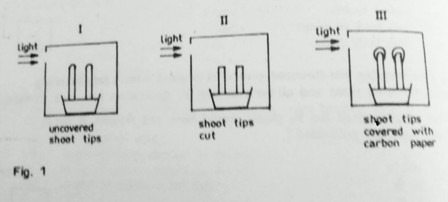
In which experiment(s) would the shoots grow straight?
A. I and II
B. I and III
C. II and III
D. III only
18. The best way to ensure that yeast added to sugar produces ethanol is by
A. Supplying a lot of oxygen to the mixture.
B. Placing the mixture in warm conditions.
C. Excluding air from the mixture.
D. Using a lot of sugar in the mixture.
19. Which of the diseases are all transmitted by mosquitoes?
A. Elephantiasis, river blindness and yellow fever.
B. Malaria, elephantiatis and river blindness.
C. Yellow fever, river blindness and malaria.
D. Yellow fever, malaria and elephantiasis.
20. Which one of the following organisms can reproduce both sexually and asexually?
A. Amoeba.
B. Spirogyra.
C. Bacteria.
D. Yeast.
21. Which of the following is affected when the cerebrum is damaged?
A. Breathing and heart beat.
B. Memory and voluntary actions.
C. Body balance and osmoregulation.
D. Osmoregulation and temperature control.
22. Which one of the following characteristics of an organism is most important in constructing a dichotomous key?
A. Body structure.
B. Body color.
C. Body size.
D. Age of organism.
23. When 80cm3 of soil, the volume of the mixture was 140 cm3. What was the percentage of air in the soil sample?
A. 20 %
B. 40 %
C. 60 %
D. 80 %
24. Cutting of fallopian tubes in a woman prevents conception because
A. Ovaries stop producing eggs.
B. Implantation does not occur.
C. Sperms do no reach the egg.
D. Sperm are destroyed.
25. Which one of the following sets of characteristics of leaves enables them to absorb maximum light?
A. Broad lamina, tightly packed palisade cells.
B. Being thin, possession of numerous stomata.
C. Possession of numerous stomata, waxy cuticle.
D. Being thin, large intercellular spaces.
26. Figure 2 is a transverse section of a dicotyledonous root.
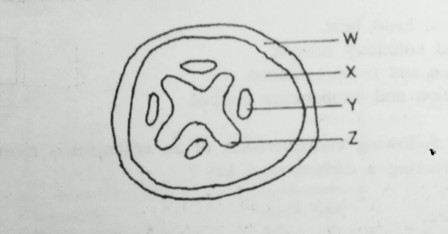
Which one of the parts labelled, is responsible for the conduction of mineral salts and water?
A. W
B. X
C. Y
D. Z
27. Which one of the following characteristics of insects them to live in dry habitats?
A. Spiracles.
B. Hairy bodies
C. Waxy cuticle
D. Wings
28. Controlled feeding on food rich in vitamin A may improve
A. Calcium deposition.
B. Number of red blood cells
C. Night vision.
D. Healing of wounds.
29. Which one of the following sets consists of hormones produced by mammalian reproductive organs?
A. Follicle stimulating hormone and testosterone.
B. Progesterone and testosterone.
C. Oestrogen and luteinizing hormones.
D. Follicle stimulating hormone and oestrogen.
30. Lichens are usually the first plants to colonize a rocky surface because they
A. Possess strong roots.
B. Require little water.
C. Are resistant to desiccation.
D. Are able to photosynthesize.
SECTION B
Answer all questions in this section. Answers must be written in the spaces provided.
31. Three equal sized shoots X, Y and Z bearing the same number of leaves from similar herbaceous plants were treated as follows:
X - Had the upper epidermis of all its leaves covered with petroleum jelly.
Y - Had the lower epidermis of all its leaves covered with petroleum jelly.
Z - All its leaves were left uncovered.
The three shoots were cut under and each placed in one of the three identical photometers. All the photometers were then left under a shade. After 5 minutes, the photometer bearing shoot Z was transferred to a sunny place. The movement of the air bubble in each photometer was recorded every minute for 10 minutes. The results are shown in figure 3.
Use the information to answer the questions that follow.
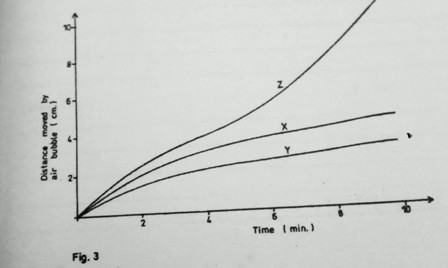
a) Describe the pattern of movement of the air bubble in each of the three photometers during the time of the experiment.
(i) X
(ii) Y
(iii) Z
b) Explain the pattern of movement of the air bubble in each photometer.
(i) X
(ii) Y
(iii) Z
c) Why were similar shoots and photometers used and all the three photometers placed under a shade?
d) The movement of the air bubble in the photometer is a measure of water uptake rather than water loss. Why is this so?
32. Figure 4 represents the carbon cycle.
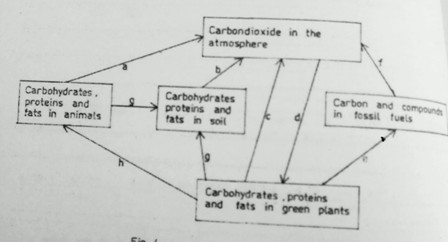
a) Name the process labelled a, c, f and g.
a..............................................................................
c............................................................................
f..............................................................................
g............................................................................
b) State one physical factor that promotes process b.
c) Give two uses of process d to animals.
d) Describe one way in which process e may be harmful.
e) (i) Suggest one human activity that tends to lower the level of carbon dioxide in the atmosphere.
(ii) Explain how the activity suggested in (e)(i) lowers the level of carbon dioxide in the atmosphere.
33. Figure 5 represents a section through a mammalian eye
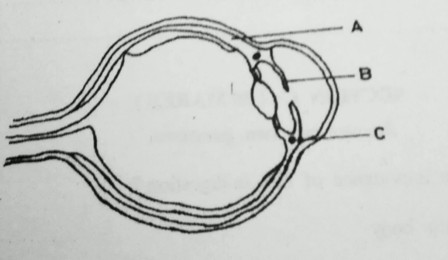
a) Give two functions of structure A to the eye.
b) (i) What stimulus does structure B respond to?
(ii) How does structure B respond to the stimulus stated in (b)(i)?
c) How is part C involved in the change of focus of the eye from a distant object to a near object?
SECTION C
Answer any two questions.
34. a) What is the importance of bile in digestion?
b) How does the body.
(i) Regulate the level of glucose in the blood?
(ii) Deal with amino acids?
35. a) Explain how flowers are adapted to wind pollination.
b) What are the benefits of sexual reproduction in plants?
36. a) (i) what is meant by mitosis?
(ii) What is the importance of mitosis to living things?
b) Give differences between mitosis and metosis.
37. a) How are birds adapted to flight?
b) With the aid of diagrams, describe how wings are moved up and down during flight in a bird.
